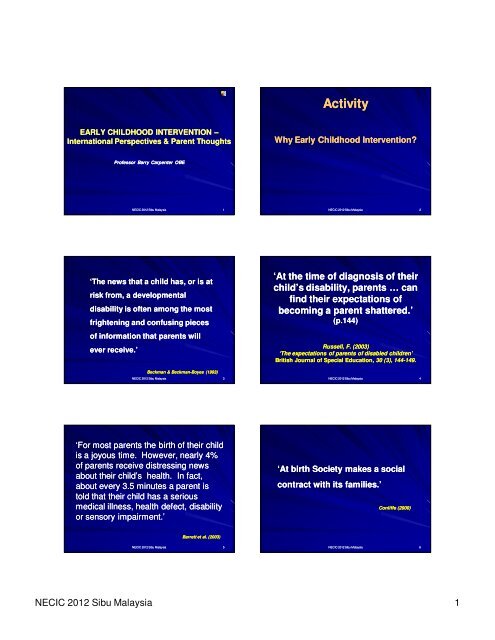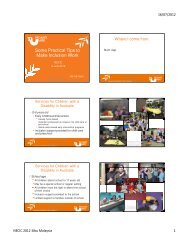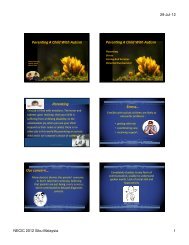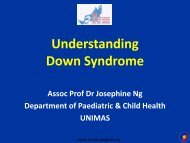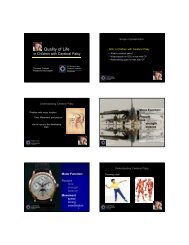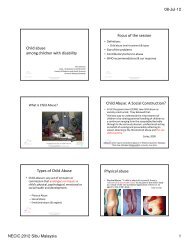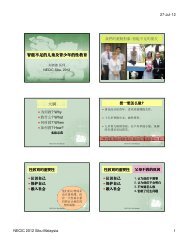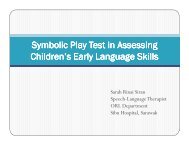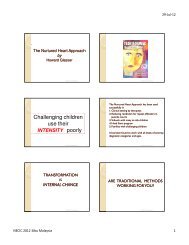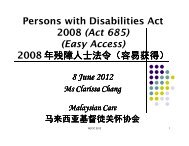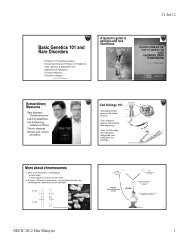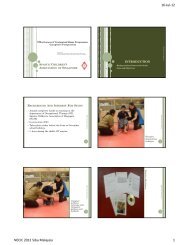Activity - Agape Centre Sibu
Activity - Agape Centre Sibu
Activity - Agape Centre Sibu
You also want an ePaper? Increase the reach of your titles
YUMPU automatically turns print PDFs into web optimized ePapers that Google loves.
<strong>Activity</strong>EARLY CHILDHOOD INTERVENTION –International Perspectives & Parent ThoughtsWhy Early Childhood Intervention?Professor Barry Carpenter OBENECIC 2012 <strong>Sibu</strong> Malaysia1NECIC 2012 <strong>Sibu</strong> Malaysia2‘The news that a child has, or is atrisk from, a developmentaldisability is often among the mostfrightening and confusing pieces‘At the time of diagnosis of theirchild’s disability, parents … canfind their expectations ofbecoming a parent shattered.’(p.144)of information that parents willever receive.’Russell, F. (2003)‘The expectations of parents of disabled children’British Journal of Special Education, , 30 (3), 144-149. 149.Beckman & Beckman-Boyes Boyes (1993)NECIC 2012 <strong>Sibu</strong> Malaysia3NECIC 2012 <strong>Sibu</strong> Malaysia4‘For most parents the birth of their childis a joyous time. However, nearly 4%of parents receive distressing newsabout their child’s health. In fact,about every 3.5 minutes a parent istold that their child has a seriousmedical illness, health defect, disabilityor sensory impairment.’‘At birth Society makes a socialcontract with its families.’Conliffe (2000)Barrett et al. (2003)NECIC 2012 <strong>Sibu</strong> Malaysia5NECIC 2012 <strong>Sibu</strong> Malaysia6NECIC 2012 <strong>Sibu</strong> Malaysia 1
<strong>Activity</strong>What is our definition ofEarly Childhood Intervention?‘Early Intervention can be defined in all forms ofchild-oriented training activities and parent-oriented guidance activities which areimplemented in direct and immediateconsequence of the identification of thedevelopmental condition. Early Interventionpertains to the child as well as to the parents, thefamily and the broader network.’Heinen (1997, p.6)NECIC 2012 <strong>Sibu</strong> Malaysia7NECIC 2012 <strong>Sibu</strong> Malaysia8‘Providing effective Early Intervention programmes forvulnerable children and their families constitutes oneof the most important challenges for contemporarysocieties. State-of-the-art intervention requires thecontributions of specialists from many disciplines, theconstruction of programmes that are firmly rooted inbio-medical and behavioural research, a programmedevelopment component that is capable ofincorporating emerging research findings, andadvocates and administrators to ensure that funding,personnel and related resources policies are availableand consistent with the knowledge base and goals ofEarly Intervention.’International Society for Early InterventionNECIC 2012 <strong>Sibu</strong> Malaysia9Early Intervention – the cornerstone ofGovernment strategy in ensuring that ‘everychild matters’‘Early intervention is the cornerstone of ourstrategy. ‘Every Child Matters’ recognisedthe lasting benefits of early intervention –providing a sound foundation for futurelearning and development … it shouldmean that help is available as early aspossible, reducing the risk of long-termunder-achievement and dissatisfaction’‘Removing Barriers to Achievement’, 2004NECIC 2012 <strong>Sibu</strong> Malaysia10The Government proposes….‘A modern family policy for the21st century, which starts fromwhat helps family life to flourish’The Children’s Plan (2008)‘Early Intervention means professionals working inpartnership with parents of children with special needsto help their children develop their knowledge andskills to reach their potential. It builds upon thestrengths found in all children and families. Researchand practice have proven that Early Interventionproduces immediate and long term benefits forchildren with disabilities, their families, and society.’Carpenter (2001)NECIC 2012 <strong>Sibu</strong> Malaysia11NECIC 2012 <strong>Sibu</strong> Malaysia12NECIC 2012 <strong>Sibu</strong> Malaysia 2
‘Early Intervention is best conceptualisedas a system designed to support familypatterns of interaction that best promotechildren’s development.’Guralnick (2001)‘Early Childhood Interventionis a dialogue between thedifferent actors – parents,child, professionals,financing bodies andresearch’NECIC 2012 <strong>Sibu</strong> Malaysia13Pretis, M. (2006)NECIC 2012 <strong>Sibu</strong> Malaysia14<strong>Activity</strong>Key goals of Early ChildhoodIntervention: a reviewWhat is the purpose of EarlyChildhood Intervention – its goals?1. To support families in supporting their children’sdevelopment2. To promote children’s development in key domains(cognitive, social, physical, emotional, linguistic)via early years curriculum and learningopportunities3. To promote children’s coping confidence4. To prevent the emergence of future problemsNECIC 2012 <strong>Sibu</strong> Malaysia15NECIC 2012 <strong>Sibu</strong> MalaysiaWolfendale (2000)16<strong>Activity</strong>What is the ‘how’ of Early ChildhoodIntervention – our practices?Key reciprocal functions ofEarly Childhood InterventionSupportEducationLiaisonCommunicationThe provision of informationCollaborationResourcesAdviceCarpenter (2004)NECIC 2012 <strong>Sibu</strong> Malaysia17NECIC 2012 <strong>Sibu</strong> Malaysia18NECIC 2012 <strong>Sibu</strong> Malaysia 3
What could have helped?(Ranked for importance)‘Fragmented services createvulnerable families.’Christine LenehanFebruary 2004‘The Children’s National Service Framework’Paper to the DfES Conference‘Removing Barriers to Achievement’25 February 20041. A break or more breaks, or more flexible breaks2. Emotional support / counselling3. Support and information around diagnosis4. Fewer financial worries5. Help and support from families6. Professional support7. Support for the father8. Recognition of the needs of the whole family9. Practical help at home10. Information about services and entitlementfrom a survey of over 2000 parents in the UKwho have a disabled childNECIC 2012 <strong>Sibu</strong> Malaysia19(Contact a Family (2004) ‘Relationships – No time for us’.http://www.cafamily.org.uk/relationships.html; ; 27.04.2004)NECIC 2012 <strong>Sibu</strong> Malaysia20<strong>Activity</strong>What are some of the futurechallenges for Early ChildhoodIntervention – the children…?In New Zealand,recently reported figures suggesta 90% survival rate for pre-terminfants less than 1,500 grams,with a 63% disability factor.(Woodward et al., 2003)NECIC 2012 <strong>Sibu</strong> Malaysia21NECIC 2012 <strong>Sibu</strong> Malaysia22EPICure UK StudyLow normalscores/ mildimpairments32%No problems22%Established 199580% survival of children born at less than 26 weeksLongitudinal studySeveredisability22%http://www.nottingham.ac.uk/human-development/EPICure/Moderate disability24%(Marlow et al., 2005)NECIC 2012 <strong>Sibu</strong> Malaysia23Proportion of children with disability out of241 children seen at 6 yearsby comparison with their classmates (Marlow et al., 2005)NECIC 2012 <strong>Sibu</strong> Malaysia24NECIC 2012 <strong>Sibu</strong> Malaysia 4
So, for many, life begins like this…or like this…NECIC 2012 <strong>Sibu</strong> Malaysia25NECIC 2012 <strong>Sibu</strong> Malaysia26‘The first year of life givesyou the organisationalpattern of how you copewith external stimuli.’Patricia Champion (New Zealand) (2005)In B. Carpenter and J. EgertonEarly Childhood InterventionWorcs: Sunfield PublicationsChallenges of prematurity: For the motherBirth period coloured by fear and distressThe ‘unexpected’IllnessAttention on the baby and its survivalHer experience goes unprocessedShe is not rehabilitated following the birthNormal social mores ignored – suspended visiting, celebrations,congratulation cardsSignificant interruptions to biological wiringTransition from pregnant person to new mother is delayed (andmay never happen)Suspended griefGreater than usual risk of post-natal depressionNECIC 2012 <strong>Sibu</strong> Malaysia27NECIC 2012 <strong>Sibu</strong> Malaysia(After Patricia Champion, 1998) 28The Perils of Alcohol in Pregnancy“…. Even moderate consumption of alcoholhad a serious effect on the formation of thebody’s central nervous system. Thisindicates that the nerve pathways in the brainhave been damaged”.Lecture given by Professor Peter Hepper, University of Belfast,Foetal Behaviour Research Unit to the Royal Society of Medicine16 November 2005NECIC 2012 <strong>Sibu</strong> Malaysia29NECIC 2012 <strong>Sibu</strong> Malaysia30NECIC 2012 <strong>Sibu</strong> Malaysia 5
Hepper’s study appears to corroborate USresearch, conducted after birth, whichshows that drinking during pregnancylowers a child’s IQ and increaseshyperactivity.Hepper,P. G., Dornan,J. C. & Little, J. F. (2005)Maternal alcohol consumption during pregnancymay delay the development of spontaneous foetalstartle behaviourPhysiology & Behaviour, , 83, 711-714714Foetal Alcohol SyndromeHow is it caused?Alcohol is a teratogen.It crosses the placenta within 10–15 minutesof an alcoholic drink being consumed.Umbilicus goes white and flaccid.One unit of alcohol remains in the mother’ssystem for approx. 1 hour (longer in ababy’s).Results in reduction of brain cells andmigration of cells to the wrong place.NECIC 2012 <strong>Sibu</strong> Malaysia31NECIC 2012 <strong>Sibu</strong> Malaysia32Foetal Alcohol Spectrum Disorder(FASD)FASD is the single biggest cause of non-geneticlearning disability.1 in 300 children are affected (1 in 666 children withDown’s syndrome).In the UK, this amounts to 600–1,200 occurrences perannum.England has the biggest binge-drinking, femalepopulation in the world. A quarter of women aged 16–24 years drink more than 21 units of alcohol per week.(14 units is the recommended maximum.) (Health Surveyfor England, 2003)NECIC 2012 <strong>Sibu</strong> MalaysiaContinued…/33Excess drinking lowers babies’ birth weights – morethan 20 units of alcohol causes intellectual impairment.Babies with FASD have substantially smaller brainsthan average.In France, legislation demands that health warningsare displayed on alcohol bottles.In the US, the warning on alcohol bottles states:‘Drinking while pregnant is overly risky for the foetus:it is the major cause of mental retardation.’Sources:Dr Moira Plant, Alcohol Research Group, Tommy’s Charity, LondonDr Raja Mukherjee, St George’s Medical School, LondonFURTHER INFORMATION: www.fasaware.co.uk / www.nofas.orgNECIC 2012 <strong>Sibu</strong> Malaysia34Prevalence of autism60 per 10,000 (1 in166) children under8 yearsMedical ResearchCouncil,200191 per 10,000 in thetotal population (1 inevery 110 people)National AutisticSociety,20021 in 800 schoolchildren (previously1 in 1,000)Department ofHealth,2002Professor Baird, whose work is published inThe Lancet, said: ‘Prevalence of autism andrelated ASD’s is substantially higher thanpreviously recognised’ She added:‘Services in health, education and socialcare will need to recognise the needs ofchildren with some form of ASD, whoconstitute 1% of the child population’Baird, G., Simonoff, E., Pickles, A., Chandler, S., Loucas, T.,Meldrum, D. and Charman, T. (2006) ‘Prevalence of disordersof the autism spectrum in a population cohort of children inSouth Thames: the Special Needs and Autism Project (SNAP’,The Lancet, 368 (9531), 210-215NECIC 2012 <strong>Sibu</strong> Malaysia35NECIC 2012 <strong>Sibu</strong> Malaysia36NECIC 2012 <strong>Sibu</strong> Malaysia 6
‘Over recent years there has been amajor rise in the rate of diagnosedautism. The main explanation for thisis to be found in better ascertainmentand a broadening of the diagnosticconcept’In 2005 there were 77 casesof measles: by June 2006there had been 449 cases(Rutter, 2005, p. 231)(Health Protection Agency, 2006)Rutter, M. (2005) Invited Review: ‘Aetiology of autism: findings andquestions’. Journal of Intellectual Disability Research, 49 (4), 231-238NECIC 2012 <strong>Sibu</strong> Malaysia37NECIC 2012 <strong>Sibu</strong> Malaysia38FAS and ADHDThe mental health problems of young children“We believe that a proportion of children who haveADHD may have developed it as a result of theirmother’s drinking during pregnancy”“The startle movement (in the womb) is clearly notnormal and would seem to indicate the child hasthe traits of fidgeting which we see in ADHD”Margaret Barrow (2005)Clinical Geneticist, Leicester Royal Infirmary, UKquoted inCarr-Brown, J. and Halle, M. (2005) 'Twitches that indicate alcohol may hurtbabies', The Sunday Times, November 20(http://www.acbr.com/fas/AlcoholFetusUltrasound.htmhttp://www.acbr.com/fas/AlcoholFetusUltrasound.htm)Also, Royal Society of Medicine Conference (2005)“Alcohol in the Womb”: The link to FASDhttp://www.fasdconnections.ca/id108.htmNECIC 2012 <strong>Sibu</strong> Malaysia39Emotional disorders, e.g. anxiety states, phobias, anddepressionConduct disorders, e.g. aggression, defiance, anti-socialbehaviourHyperkinetic disorders, e.g. disturbance of activity andattentionDevelopmental disorders, e.g. delay in acquiring certain skillssuch as speech, social ability or bladder controlAttachment disorders, e.g. children who are markedlydistressed or socially impaired as a result of an extremelyabnormal pattern of attachment to parents or major caregiversEating disorders, e.g. pre-school eating problemsHabit disorders, e.g. sleeping problems, soiling, spontaneousurination.NECIC 2012 <strong>Sibu</strong> Malaysia40‘4 in 10 young people with learningdisabilities [in the age range 13–25years old] will develop a mentalhealth problem.’‘One in five children have SEN,but children with SEN are threetimes more likely to havemental problems.’From Count Us In: The National Inquiryinto the Mental Health Needs of YoungPeople with Learning Disabilities(Office of National Statistics, 2000)NECIC 2012 <strong>Sibu</strong> Malaysia41NECIC 2012 <strong>Sibu</strong> Malaysia42NECIC 2012 <strong>Sibu</strong> Malaysia 7
‘Poverty can increase the risk of a child havingan impairment… Having a disabled child canalso mean that parents find it harder tomaintain full-time employment, their housingcan be inadequate for their child’s needs, andexpenditure on basic needs is increased.’55% of families with a disabledchild are living in poverty or onthe margins of poverty.(General Household Survey, 2002)(Prime Minister’s Strategy Unit, 2005, p. 86)NECIC 2012 <strong>Sibu</strong> Malaysia43NECIC 2012 <strong>Sibu</strong> Malaysia44‘Families of children with severe disabilitiesHousing – three quarters offamilies with a disabled childlive in an unsuitable home.are less likely to be car or telephone owners,even though they are more dependent onthese services.’(Family Fund Data,1998)Oldman & Beresford (2002) Housing Matters The Policy Press,Oldman & Beresford (1998) Homes Unfit for Children York: JRFNECIC 2012 <strong>Sibu</strong> Malaysia45NECIC 2012 <strong>Sibu</strong> Malaysia46<strong>Activity</strong>‘The challenge to our society is toloosen and break the stranglehold ofpoverty on the development of ourchildren.’So what do you feel are some of thefuture challenges forEarly Childhood Intervention?Mittler (2000)NECIC 2012 <strong>Sibu</strong> Malaysia47NECIC 2012 <strong>Sibu</strong> Malaysia48NECIC 2012 <strong>Sibu</strong> Malaysia 8
Challenges toEarly Childhood InterventionInclusionPractice models‘Inclusivity is key to the self-defining family.’Styles of partnershipFamily-based interventionCarpenter (2003)Carpenter (2004)NECIC 2012 <strong>Sibu</strong> Malaysia49NECIC 2012 <strong>Sibu</strong> Malaysia50A is for …Availability – presence of appropriate servicesAccessibility – services readily availableAccommodation – responsiveness toindividual needsAffordability – minimal time, money, energycostsAcceptability – individuality respectedNECIC 2012 <strong>Sibu</strong> MalaysiaSimeonsson (1998)51Features of transdisciplinary practiceLowering of disciplinary boundariesEmpathetic human beingsEmpowerment approachRecognition of the systemic nature of the familyChoice of services and level of engagementNegotiationJoint decision-makingShared perspectivesMediationMulti-level level partnership NECIC 2012 <strong>Sibu</strong> Malaysia52The Champion <strong>Centre</strong>, N.Z.The programme started with just a physioand an SLT (and the family, of course).‘In a transdisciplinary team the rolesare not fixed. Decisions are made byprofessionals collaborating at aprimary level (rather than at asecondary level as in a multi-disciplinary team). The boundariesbetween disciplines are deliberatelyblurred to employ a “targeted eclecticflexibility”.’Pagliano (1999, p.120)NECIC 2012 <strong>Sibu</strong> Malaysia53NECIC 2012 <strong>Sibu</strong> Malaysia54NECIC 2012 <strong>Sibu</strong> Malaysia 9
‘Holistic, family-oriented approachesrequire close collaboration between therange of professionals in the fields ofpedagogy, psychology, social sciencesand medicine.’Peterander (1995, p.162)Four key features of the DevelopmentalSystems ModelTo guide Early Childhood Interventionprogrammes for vulnerable children and theirfamiliesTo maximise family patterns of interactionTo address potential stressors related to risk anddisability conditionsTo advocate community-based servicesNECIC 2012 <strong>Sibu</strong> Malaysia55NECIC 2012 <strong>Sibu</strong> MalaysiaGuralnick (2001)56‘By redirecting our focus, wemay enable partnership tobecome a reality once more.Do we have the will, thecommitment, for the sake ofour families, to shift thefocus?’Carpenter (2003)Fialka and Mikus (1999) speak of the‘dance towards partnership’and remind us that‘the only magic to forming partnerships isto slowly, tenderly and persistently shareour dreams with each other, for it is ourchildren who give us the reason andopportunity to strengthen our partnershipswith others.’NECIC 2012 <strong>Sibu</strong> Malaysia57NECIC 2012 <strong>Sibu</strong> Malaysia58‘The professionalism on which you stand is not adifferent road to the one on which we tread… It’s alsothe road that’s cushioned and softened by the laughterand the smiles of love, and tears of our children. Thatroad is the same road, and, when we relate to eachother, we have the partnership that dreams are madeof. From the educational psychologist who sits withyou and tries to translate the vision you have for yourchild in the way his or her report is written, to theoccupational therapist who’ll make a separateattachment to your child’s wheelchair so the cat cancurl up next to your child, to the midwife who finds alovely position you can feed your child in even thoughit’s completely against her textbook knowledge…These are professionals who are working in the spiritof the term “partnership”.’Preethi Manuel (1996)NECIC 2012 <strong>Sibu</strong> Malaysia59‘It is difficult in a society that does notvalue disabled children to find help that isnon-judgemental. Admitting that one’schild might be harder work than manydoes not come easily if you are trying tochallenge outdated attitudes. Asking forsupport does not mean that you do notlove your child, or that you are wishingthem away.’NECIC 2012 <strong>Sibu</strong> MalaysiaWilson (2003)60NECIC 2012 <strong>Sibu</strong> Malaysia 10
‘We believe that it should not be regarded as an exoticidea for disabled children and those close to them toaspire to a quality of life comparable to that enjoyedby others who do not live with a disability. In our viewit is unacceptable at the beginning of the 21 st centuryfor the lives and experiences of disabled children andtheir families to be bereft of those features that manyof us take for granted; features which make for anordinary and reasonable quality of life. Families areour greatest resource and if they are not seen as aresource they become problems.’Family-focussed evaluationof Early Childhood Intervention…Endorses collaborative workingMutually values parents and professionalsWorks to shared agenda and shared goals.NECIC 2012 <strong>Sibu</strong> MalaysiaMencap (2001)61NECIC 2012 <strong>Sibu</strong> Malaysia62<strong>Activity</strong>So, in the new phase of developmentfor Early Childhood Intervention,what do you see asthe ‘Agenda for Development’ ?The Agenda for Development inEarly Childhood InterventionPrinciple 2: Integration and co-ordination ordinationat all levels of the Early ChildhoodIntervention system is essentialGuralnick (2005)www.sunfield.org.ukNECIC 2012 <strong>Sibu</strong> Malaysia63NECIC 2012 <strong>Sibu</strong> Malaysia64Agenda:Training on team process- evolving transdisciplinary models based onrespect for, and contributions of various disciplines.Early Childhood Intervention:an agenda for developmentCriteria for programme entryOutcome measures for successful interventionsDevelop new models for collaboration- collaborative consultation- Team-around-the-child (Limbrick, 2005)- Coaching (Espe-Schwindt, 2005)Establish leadership groups at every servicelevel to promote co-ordination andintegrationGuralnick 2005 : Carpenter & Egerton 2005NECIC 2012 <strong>Sibu</strong> Malaysia65Roles and responsibilities of professionalsDelivery of services within a changing societySustainability of intervention programmes for children withcomplex needsLong-term outcomes for whom?A first step towards InclusionCarpenter, B. and Russell, P. (2005)‘Early Intervention in the UK: current policy and practice’.In: M Guralnick (ed.) A Developmental Systems Approach to Early Intervention:National and International Perspectives. Baltimore: Paul H. Brooke.NECIC 2012 <strong>Sibu</strong> Malaysia66NECIC 2012 <strong>Sibu</strong> Malaysia 11
‘The severity of the child’s disorder, at anylevel, can leave parents exhausted to a degreethat is dependent on their stress tolerance.Many of them experience chronic pessimismand risk breakdowns in their functioning.Early intervention should seek to divert thisbleak outcome. It should seek it vigorouslyand with great endeavour.’Engagement‘It is important to do something and doit with a degree of intensity.’Mesibov (2001)Randall and Parker (1999)NECIC 2012 <strong>Sibu</strong> Malaysia67NECIC 2012 <strong>Sibu</strong> Malaysia68Major Accomplishments of Early InterventionParent – child transactionsCentrality of family centred approachesFamily Orchestrated child experiencesEffectiveness : Evidence from Model ProgrammesPrinciples of Early Intervention- Developmental framework- Integration and co-ordination- Inclusion- Early detection and identification- Surveillance & monitoring- Evaluation and feedback- Cultural competence- Evidence-based practices- Systems perspectiveGuralnick (2007)Paper to: Second Conference of the International Society on Early InterventionHeld in conjunction with the University of Zagreb’s 7 th Annual Scientific conference“Research ;in Education and Rehabilitation Science”!NECIC 2012 <strong>Sibu</strong> Malaysia69Zagreb, Croatia – 14-16 June 2007Look what effective EarlyChildhood Intervention canachieve….NECIC 2012 <strong>Sibu</strong> Malaysia70NECIC 2012 <strong>Sibu</strong> Malaysia 71NECIC 2012 <strong>Sibu</strong> Malaysia72NECIC 2012 <strong>Sibu</strong> Malaysia 12
Morgan and Serena, 11 days oldNECIC 2012 <strong>Sibu</strong> Malaysia73Serena and Morgan (20 months) in the parkwith NECIC 2012 Grandad <strong>Sibu</strong> Malaysia74‘We need a whole community todevelop a child. We are thatcommunity, and these are ourchildren.’Nigerian ProverbNECIC 2012 <strong>Sibu</strong> Malaysia75NECIC 2012 <strong>Sibu</strong> Malaysia 13


